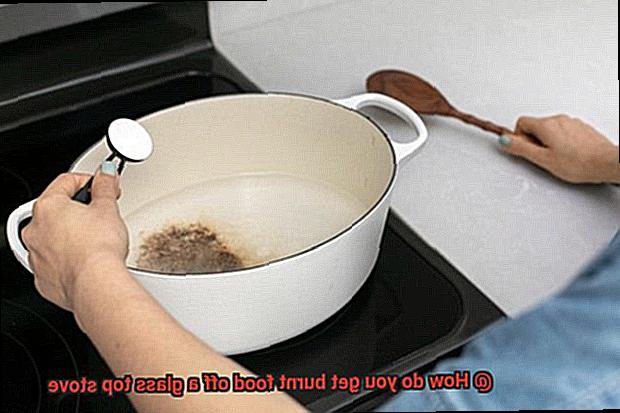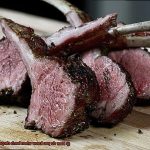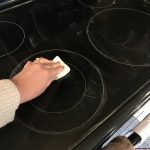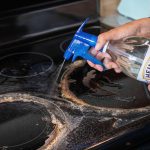Have you ever found yourself in the midst of cooking a delicious meal, only to be interrupted by a phone call or a screaming child? You rush back to the stove, only to find that your dinner has turned into a burnt mess on your glass top stove.
Don’t panic. Removing burnt food from a glass top stove is easier than you might think. With some helpful tips and a bit of elbow grease, you can restore your stovetop to its former glory.
In this blog post, we’ll explore the most effective methods for removing burnt food from a glass top stove. From everyday household items to specialized cleaning products, we’ve got all the tools you’ll need to tackle even the toughest stains.
But that’s not all. We’ll also share some best practices for maintaining the cleanliness and appearance of your glass top stove. We know how frustrating it can be to deal with spills and stains, so we’ll provide you with tips for preventing future mishaps.
So, grab your cleaning supplies and get ready to say goodbye to those unsightly stains. Your glass top stove will be shining like new in no time.
Contents
What is a Glass Top Stove?
If so, a glass top stove might be just what you need.
A glass top stove, also known as a ceramic stove, uses radiant heat to cook food. Unlike traditional stovetops with coil burners, the heating elements on a glass top stove are located beneath the smooth glass surface. This design allows for easy temperature control and a sophisticated look in your kitchen.
One of the most significant benefits of a glass top stove is its effortless cleaning process. The flat surface makes it simple to wipe down with a damp cloth or sponge, keeping it looking shiny and new. No more hard-to-reach nooks and crannies to clean.
However, it’s important to note that glass top stoves can be more delicate than other types of stoves. The smooth glass surface can crack or scratch if heavy objects are dropped on it or if abrasive materials are used to clean it. To avoid any damage, it’s crucial to use caution when cooking and follow the manufacturer’s instructions for cleaning and maintenance.
Burnt food residue can be one of the most challenging issues to deal with on a glass top stove. But don’t fret – there are effective ways to remove it without causing any harm to your stove. Start by allowing the stove to cool completely, then use a soft cloth or sponge to remove any loose debris or food particles. Next, use a specialized cleaner designed specifically for glass top stoves or natural cleaning solutions like vinegar and baking soda to get rid of the burnt-on residue.
In some cases, burnt-on residue may require more intensive cleaning methods, such as using a razor blade scraper. However, this method should only be used as a last resort and with extreme caution.
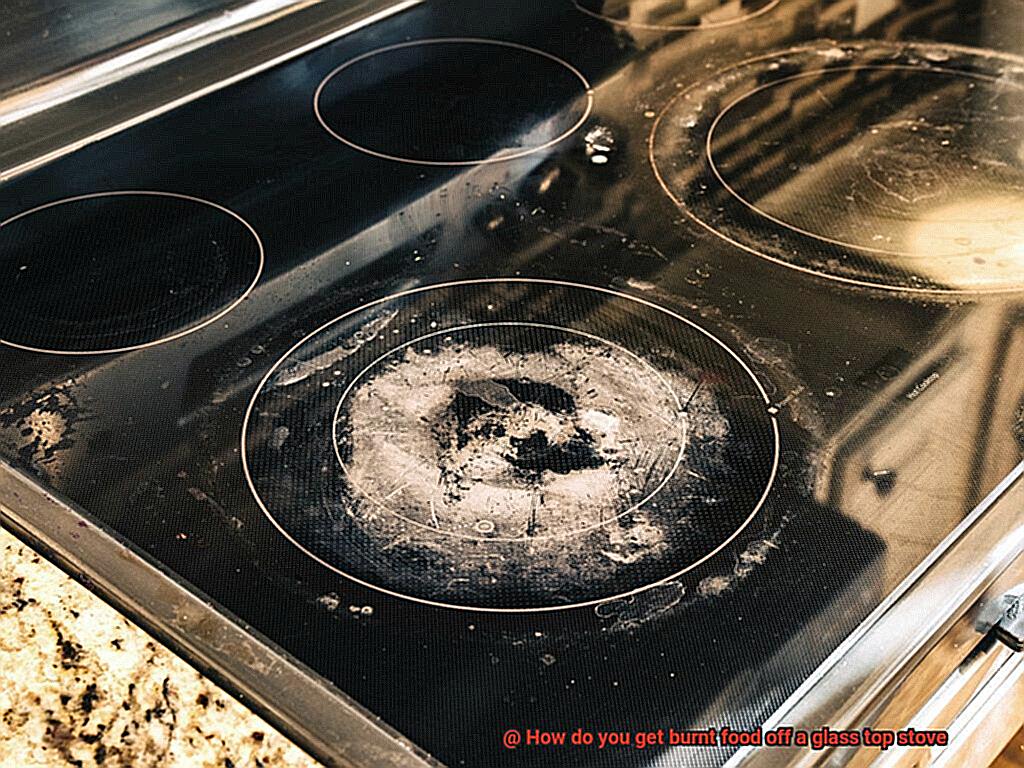
Safety Tips for Cleaning a Glass Top Stove
Cleaning a glass top stove may seem like a straightforward task, but it can be dangerous if proper safety measures are not taken. Here are five safety tips to keep in mind when cleaning your glass top stove:
Turn off and cool down the stove
Before you start cleaning, make sure that your stove is turned off and has cooled down completely. This will prevent any burns or injuries caused by a hot surface.
Protect yourself
Wear protective gear such as gloves and goggles to avoid any injuries from broken glass or chemicals. Also, make sure that the area around the stove is well-ventilated to prevent inhaling any fumes.
Use appropriate cleaning products
Only use cleaning products that are specifically designed for glass top stoves. Avoid using abrasive cleaners or scrubbers that can scratch the surface of the stove and cause irreparable damage.
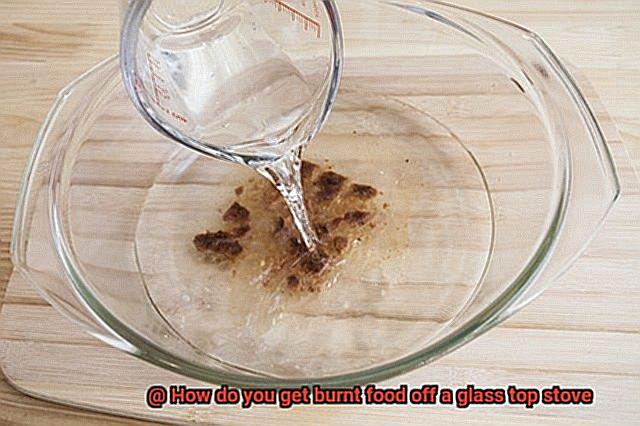
Follow manufacturer’s instructions
Always refer to the manufacturer’s instructions for cleaning and maintenance of your glass top stove. This will ensure that you are using the right methods and products for optimal performance and longevity of your appliance.
Keep children and pets away
It’s crucial to keep children and pets away from the cleaning area to prevent any accidents or injuries. Make sure that you store all cleaning products out of their reach.
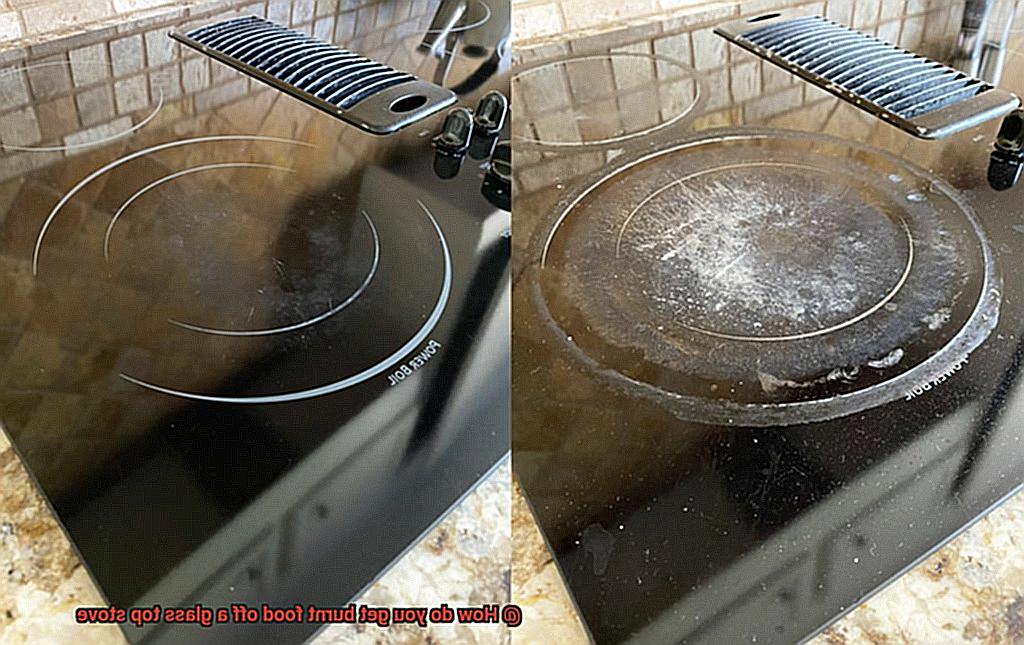
By following these safety tips, you can ensure that you clean your glass top stove effectively and safely. A clean and shiny stove not only looks great but also functions efficiently, making your cooking experience more enjoyable and hassle-free.
Removing Loose Debris and Food Particles
Fear not, as removing loose debris and food particles is the first step to bringing back its shine. As an expert in this area, I have researched and compiled some tips to help you through this task.
Firstly, safety should always come first. Make sure to turn off your stove and let it cool down completely before attempting to remove any debris or food particles. Protecting your hands with gloves is recommended, and avoid using abrasive materials that can scratch the surface.
Now, let’s dive into the steps for removing loose debris and food particles.
Step 1: Soft Cloth or Sponge
Start by grabbing a soft cloth or sponge and gently wiping away any loose debris or food particles. This step is crucial as it helps prevent scratches or damage to the glass surface.
Step 2: Avoid Abrasive Materials
Abrasive sponges or steel wool may seem like a quick fix, but they can do more harm than good. Stick to soft materials to avoid scratching the glass.
Step 3: Plastic Scraper or Specialized Cleaner
If there are stubborn food particles that won’t budge, use a plastic scraper or specialized cleaner to tackle those tough spots. It’s important to use a plastic scraper as metal scrapers can scratch the glass surface.
Step 4: Apply Cleaner and Scrape Away Burnt Food
Apply the cleaner to the affected area and let it sit for a few minutes. Then, gently scrape away the burnt food with a plastic scraper. The result? A sparkling clean glass top stove.
Using Specialized Cleaners for Burnt-on Residue
I have the solution for you: specialized cleaners. These cleaners are specifically formulated to break down even the toughest stains and grime, making your cleaning routine easier and more effective.
Before selecting a specialized cleaner, it’s crucial to read the label carefully and ensure that it’s safe for use on your specific type of stove. Some cleaners may contain harsh chemicals that can damage the surface of your stove, so it’s important to choose a product that is gentle but effective.
To begin using a specialized cleaner, turn off your stove and let it cool down completely. Then, spray the cleaner directly onto the burnt-on residue and give it a few minutes to penetrate the stain. This step is crucial in ensuring that the cleaner breaks down the residue effectively.
Next, take a soft sponge or cloth and gently scrub the area in a circular motion. Applying light pressure is key here, as excessive force can scratch the surface of your stove. Once you’ve finished scrubbing, rinse the area thoroughly with warm water and dry it with a clean towel.
If any residue remains, don’t worry. Simply repeat the process until the stain is completely removed. However, if a stain persists, it may be time to call in a professional cleaning service.
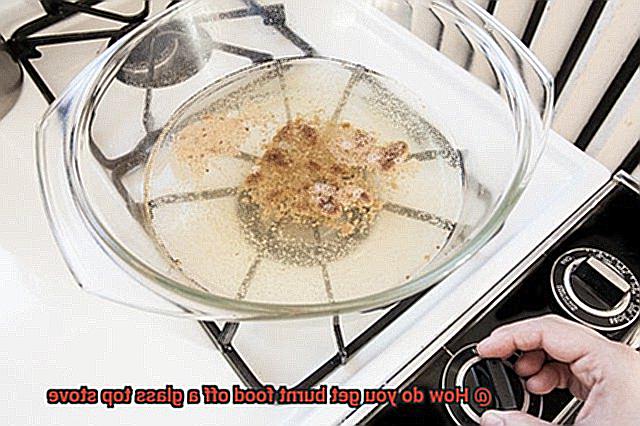
It’s important to note that some specialized cleaners may have a strong odor. To avoid any harm to yourself, use them in a well-ventilated area or wear a mask if necessary. Additionally, following the instructions on the label carefully will ensure that you don’t cause any damage to your stove.
To summarize, using specialized cleaners is an effective way to remove burnt-on residue from your glass top stove. Just remember to choose a gentle but effective product, apply light pressure when scrubbing, and follow instructions carefully.
Natural Cleaning Solutions for Burnt-on Residue
As someone who is well-versed in natural cleaning solutions, I know how important it is to find safe and effective ways to clean your glass top stove. Not only can commercial cleaners be costly, but they can also contain harsh chemicals that are harmful to both your health and the environment. That’s why I am excited to share some of the best natural cleaning solutions that you can use to remove burnt-on residue from your stove.
First up, baking soda is a popular and versatile option that can be found in most kitchens. To use baking soda, simply mix it with water to create a paste. Apply the paste to the affected area and let it sit for about 15 minutes before using a damp cloth or sponge to scrub away the residue. Baking soda’s gentle yet powerful cleaning properties make it an excellent choice for those who want a natural solution that won’t harm their glass top stove.
Another fantastic natural cleaning solution is vinegar. Mix equal parts vinegar and water in a spray bottle and apply the solution to the affected area. Let it sit for a few minutes before wiping away with a damp cloth or sponge. The acidity of vinegar helps break down burnt-on residue, leaving your stove looking shiny and clean.
Lemon juice is also an excellent option for cleaning burnt-on residue. Simply slice a lemon in half and rub it over the affected area. Allow the lemon juice to sit for a few minutes before wiping away with a damp cloth. Not only does this method work well, but it also leaves behind a refreshing citrus scent in your kitchen.
Last but not least, salt is an abrasive yet gentle natural cleaning solution that can be used on burnt-on residue. Sprinkle salt over the affected area and allow it to sit for several minutes before using a damp cloth or sponge to scrub away the residue. Salt is effective at removing tough stains without causing any damage to your glass top stove.
Intensive Cleaning Methods for Stubborn Stains
First up, we have the trusty baking soda and water mixture. This gentle yet potent method works wonders in removing even the toughest stains. Apply the mixture to the affected area and let it sit for 15 minutes before giving it a gentle scrub with a non-abrasive sponge or cloth.
If baking soda isn’t your thing, don’t fret. Commercial glass stove top cleaners are available and specially formulated to dissolve burnt-on food stains. These cleaners are safe for use on glass surfaces and can be easily applied by spreading them over the stained area and wiping them off with a damp cloth after a few minutes.
For those really stubborn stains that refuse to budge, try using a razor scraper. This tool is designed to scrape away burnt-on food without scratching the surface of your stove. However, be cautious when using this tool and only use it on areas that are not easily scratched.
Here are some additional tips to tackle specific types of stubborn stains:
- For grease stains, use a degreaser spray or a mixture of warm water and dish soap.
- For water stains, use white vinegar or lemon juice diluted with water.
- For rust stains, use a mixture of baking soda and hydrogen peroxide.
Tips for Maintaining Your Glass Top Stove
A glass top stove is a beautiful addition to any kitchen, but it can be challenging to maintain its sleek appearance. Burnt food, spills, and scratches can quickly accumulate if not taken care of properly. Here are five sub-sections with tips and tricks for maintaining your glass top stove.
Clean Spills Immediately
Spills are inevitable when cooking, but leaving them on your glass top stove can lead to permanent stains or damage to the surface. To prevent this, clean spills immediately after they occur. Use a soft cloth or sponge with warm water and a mild detergent to wipe away any messes. Avoid using abrasive sponges or harsh chemicals that can scratch or damage the glass surface.
Use the Right Cookware
Choosing the right cookware is essential for maintaining your glass top stove’s longevity and preventing scratches or cracks on the surface. Avoid using cast iron or stoneware as they can scratch or damage the glass surface. Instead, opt for smooth-bottomed cookware such as stainless steel or aluminum. Additionally, make sure the cookware is properly sized for the heating element to avoid uneven heating and potential damage to the stove.
Be Gentle
When cleaning your glass top stove, treat it with care. Avoid pressing too hard or scrubbing too vigorously, as this can cause damage to the surface. Use a soft cloth or sponge that won’t scratch the surface, such as microfiber cloths designed for glass surfaces. Gently wipe away any debris or stains using circular motions and mild cleaning solutions.
Avoid Abrasive Cleaners
Abrasive cleaners can scratch the surface of your glass top stove, making it more challenging to clean in the future. Instead, use non-abrasive cleaners or natural solutions such as vinegar and water. Mix equal parts of white vinegar and water in a spray bottle and apply it to the burnt-on residue. Let it sit for a few minutes before sprinkling baking soda over the area. Use a soft cloth or sponge to gently scrub the surface in circular motions. Rinse the area thoroughly with water and dry with a clean cloth.
Consider Purchasing a Specialized Cleaner
For stubborn stains or burnt-on food, consider purchasing a specialized glass top stove cleaner. These cleaners are designed specifically for glass stovetops and can effectively remove tough stains without damaging the surface. Follow the instructions carefully and apply the cleaner in a circular motion with a soft cloth. Rinse thoroughly with warm water and dry with a clean cloth.
MnvBrMehn_k” >
Conclusion
In conclusion, don’t let burnt food on your glass top stove get you down. With the right tools and techniques, cleaning it up can be a breeze. Remember that glass top stoves require gentle care and attention, so always follow safety precautions when cleaning.
Thankfully, natural cleaning solutions like baking soda, vinegar, lemon juice, and salt are effective at removing burnt-on residue without harsh chemicals. If those don’t work for more stubborn stains, specialized cleaners are available as a last resort.
But prevention is key to maintaining the longevity of your stove’s appearance. Clean spills immediately, use appropriate cookware, avoid abrasive cleaners and be gentle when wiping down your stove. Consider investing in a specialized cleaner for tough stains.
By following these tips and techniques, you’ll keep your glass top stove looking shiny and new for years to come. So next time you encounter burnt-on residue on your stove – don’t panic.

